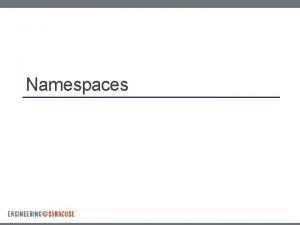Lecture 23 Namespaces Mop up Namespaces n At







- Slides: 7

Lecture 23 Namespaces & Mop up

Namespaces n At the beginning of the semester, I asked you to take it on faith that if you wanted to use the functions defined in <iostream> you would need to add the following line of code to your program: n n n using namespace std; A namespace is a method by which you can encapsulate any combination of classes, constants, globals, types into a neat “package”. Without using special directives, such classes, globals, etc. , can only be accessed through the namespace’s name. Namespaces look somewhat like a class declaration. You define a name for your namespace and use curly braces to define a scope for it

Namespaces (cont) n n Everything which occurs in that scope is “hidden” in your namespace. It might look something like this: // // Number. h // namespace Cornell. CS 213 { class Number { public: … }; } // Defines a namespace named Cornell. CS 213

Namespaces (cont) n n Given the previous namespace declaration, you can access Number in one of three ways. First, you can use Number’s new fully qualified name anywhere in your code: n n Second you can specifically designate that, for the current file being compiled, you’d like to use the Number implementation in the Cornell. CS 213 namespace: n n n Cornell. CS 213: : Number a. Num; using Cornell. CS 213: : Number; Number a. Num; Third, you can simply state that you’d like to use all the contents of a given namespace without qualification. This is what we’ve been doing all year with the std namespace: n n using namespace Cornell. CS 213; Number a. Num;

Namespaces (cont) n n n Now, a cool feature with namespaces is that a single namespace may span multiple files. Any time a namespace keyword is encountered, the contents that follow are “appended” to any previously existing entries in that namespace. So given our example which encapsulated Number into Cornell. CS 213, if the following were encountered: namespace Cornell. CS 213 { class Person { … }; class Student : public Person { … }; class Instructor : public Person { … }; } n It would also be accessible in the Cornell. CS 213 namespace, along with Number.

Namespaces (cont) n n You may also define “aliases” to existing namespaces to shorten their names. Consider the following namespace: n n namespace AReally. Long. Name. Space. Name { … } You can use the following call to shorten it: n namespace X = AReally. Long. Name. Space. Name;

Mop-Up Any Questions?













